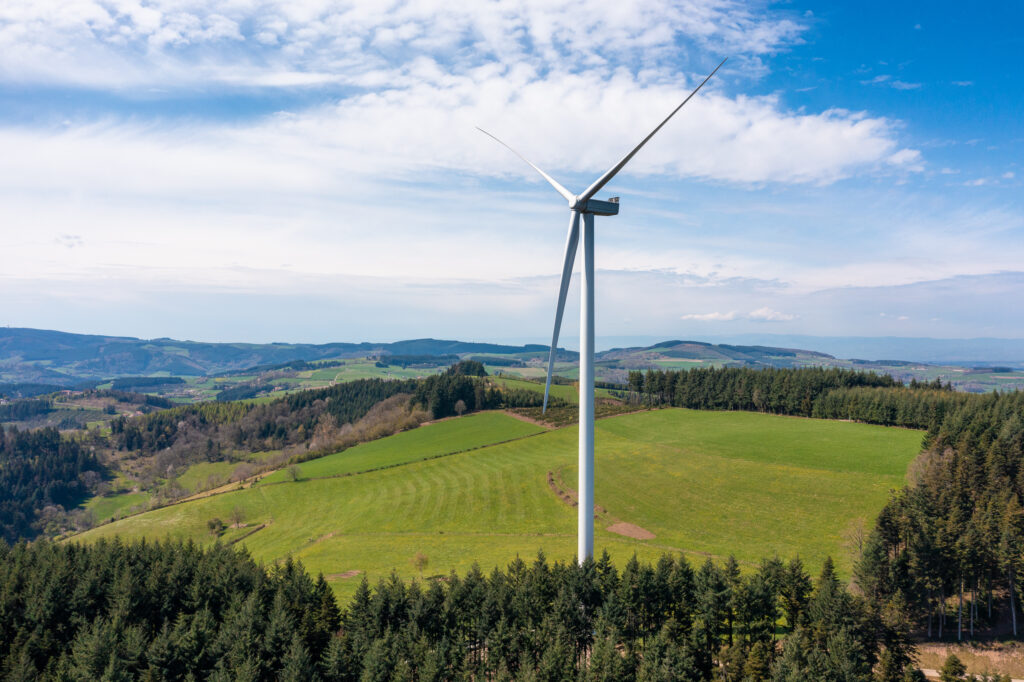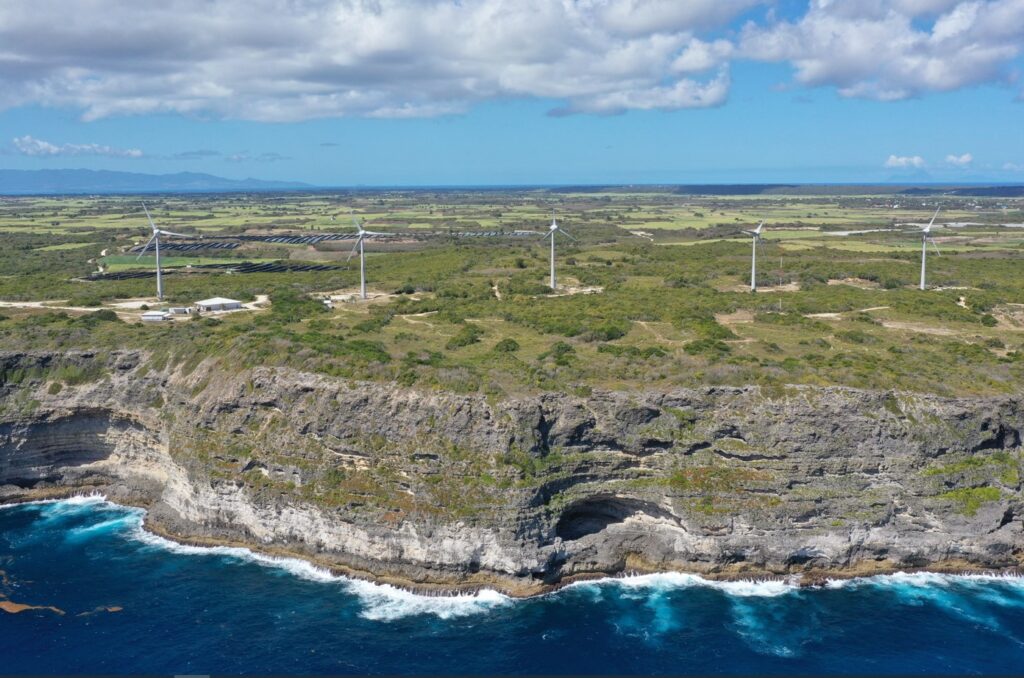Transforming wind, a natural and inexhaustible resource, into electrical energy, this is the principle of wind energy.
Grouped together in wind farms, wind turbines produce renewable, low-carbon energy, thus contributing to the energy transition.





Wind turbines produce electricity when the wind blows between 10 and 90 km/h (beyond that, they stop for safety reasons). The wind drives the blades of the wind turbine which turn a generator to produce electricity. It's the same operation as a bicycle dynamo!
When the wind picks up, the basket (1) of the wind turbine faces the wind and the blades (2) gradually begin to rotate. The rotor (3) drives the generator (4) which transforms wind energy into electricity.
The electricity is then carried through underground cables to the national electricity grid, then powering our towns and villages.
A wind farm of 10 wind turbines (20 MW) produces the equivalent of the annual electricity consumption of 27,000 inhabitants.
 A wind turbine produces electricity when there is wind!
A wind turbine produces electricity when there is wind!A wind turbine operates approximately 80 to 90% of the time but its production depends on the power of the winds, it's logical!
Finally, it is estimated that a wind turbine produces over the year the equivalent of what it would produce if it operated at full power 25% of the time. This is called the load factor.
When there is no wind, don't panic! We can count on a mix combining several energy sources such as nuclear and hydraulic. We can also count on an interconnected network on a European scale and the development of storage technologies.
The construction of an onshore wind farm takes 9 to 12 months and requires the intervention of several trades.
To ensure the maintenance of our wind turbines, our technicians work throughout France. A single objective: to ensure optimal electricity production.
Come, shall we take you? 
Although they produce renewable energy that is useful to everyone, it is not possible to install wind turbines just anywhere! The choice of a site to install a wind farm meets several criteria:
The area must be windy, accessible and located near the electrical network.
The installation of the wind farm must be compatible with the biodiversity of the site. A minimum distance of 500 meters from homes must also be respected.
The installation of wind turbines must not interfere with existing human activities (distance from classified sites, military radar, etc.)
A wind farm cannot be decided in an office! For each project, we are setting up a broad consultation, bringing together all local elected officials, environmental associations, stakeholders from the economic world, etc.
We also hold information meetings for local residents and the general public in order to inform them and gather their opinions. Co-construction workshops can also be organized and carrying out and sharing detailed environmental studies often allows one to learn more about the local environment.
On some of our projects, we set up a crowdfunding system, allowing local residents to invest financially in the project!
A good way for residents to be involved and become actors in the region's energy transition.
 Respect for biodiversity at the heart of projects!
Respect for biodiversity at the heart of projects!If wind turbines contribute to the energy transition and the fight against climate change, it is important that their installation also takes place with strict respect for the environment.
For each project, we carry out studies over several years in order to understand the biodiversity issues of the site, and thus design a project that minimizes its impact on the local environment. We will therefore carry out precise studies on each component of the site's biodiversity (birds, terrestrial species, local flora, etc.).

 Can a wind turbine be recycled?
Can a wind turbine be recycled?A wind turbine is designed to produce electricity for a period of 20 to 25 years. Beyond that, it can be resold on the second-hand market, reused in the form of spare parts, or recycled in specific sectors.
Today, more than 90% of the total weight of a wind turbine is recyclable. The concrete foundation can be crushed and reused, for example in road underlays. The mast and nacelle are made of steel and electrical equipment, which are easily recyclable. Regarding the blades, they are made of composite materials (like boat hulls or airplane wings), the industry is mobilized to find sustainable solutions!
Response from EDF Renewables:
For each project, the choice of the location site is the subject of studies over several years. These studies, carried out by independent scientists, are analyzed by State services as part of authorization requests. Once the park is put into service, we set up regular environmental monitoring and can, if necessary, implement appropriate measures.
 Focus
Focus 
Did you know that nature can help make wind turbines quieter? This is called biomimicry! On some of our wind turbines, We were inspired by the shape of owl wings to develop a process that reduces the noise of the blades cutting through the air as they rotate. Indeed, owl wings are slightly serrated at their lower edge, cutting through the air much more silently! An innovation developed with the wind turbine manufacturer which contributes to the development of projects!
Over the last 10 years, the average power of wind turbines has been multiplied by 2. This increase in power has also allowed wind power to become cheaper; it is today one of the least expensive energies. expensive. Since 2010, the cost of wind energy has been divided by 3.
A wind farm is the symbol of dynamism and a region engaged in the energy transition. But beyond that, a wind farm is also the mobilization of local companies during the construction phases and the creation of lasting local jobs for the operation.
A wind farm also generates significant economic benefits in the form of taxes for local authorities. These taxes allow communities to finance new equipment such as community halls, collective spaces or even to consider, for some, a reduction in local taxes.
A wind farm can also stimulate curiosity and be the start of a local project focused on sustainable development.
 Focus
Focus 
Wind power is also a job-creating sector. In 2022, the French sector will have more than 25,500 jobs, an increase of 39% compared to 2018. Throughout France, wind maintenance professions are recruiting, in the service of the energy transition!
Wind turbine : A wind turbine is a machine that transforms the kinetic energy of the wind into electrical energy. It consists of aerodynamic blades that capture the wind and turn a rotor. This rotational movement is then converted into electricity using a generator located in the nacelle. It's the same principle as a dynamo on a bicycle.
electricity : A form of energy that results from the movement of charged particles, called electrons. It can be produced in a variety of ways, including through power plants that use energy sources such as coal, natural gas, wind, solar or water. Electricity is used to power our electrical appliances, light our homes, operate machines and facilitate our communications. It is essential in our daily lives and plays a key role in technological and industrial development.
Consultation : Consultation is a process of dialogue and collaboration between different stakeholders with the aim of finding common solutions to specific problems or issues. This generally involves the active participation of different actors, such as citizens, non-governmental organizations, businesses, local elected officials, experts and representatives of civil society.
Recycling : Process of transforming waste and used materials into new products or raw materials in order to reuse them. It is a practice aimed at reducing the amount of waste sent to landfills and preserving natural resources by avoiding the extraction of new raw materials. Recycling can be done on various types of materials such as paper, glass, plastic, metal, etc. It contributes to the preservation of the environment by reducing pollution, greenhouse gas emissions and energy consumption.
Find all the resources available on this theme in the media library
43 Boulevard des Bouvets
CS 90310
92741 NANTERRE CEDEX
©2025 EDF Renewables